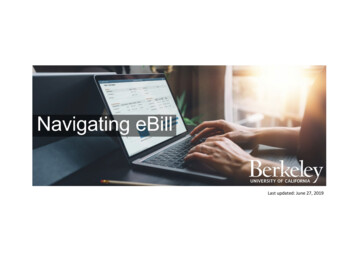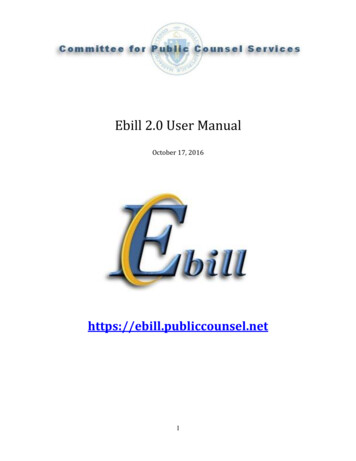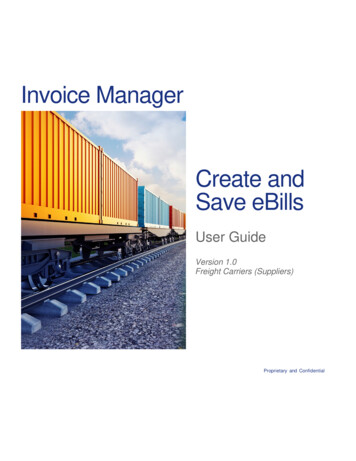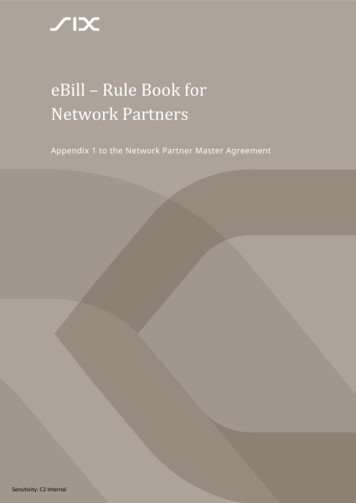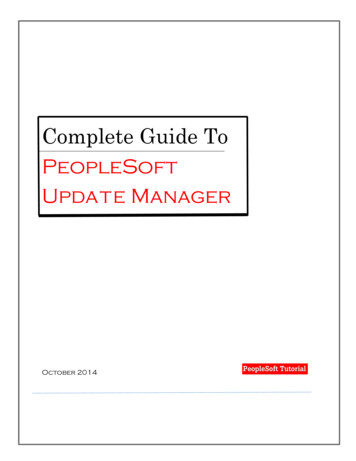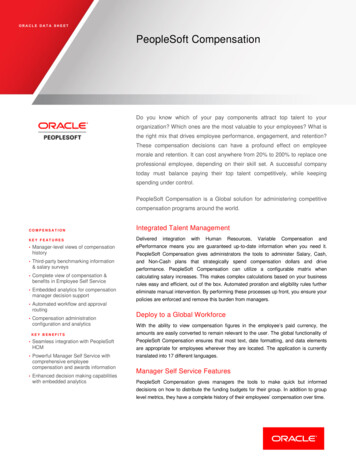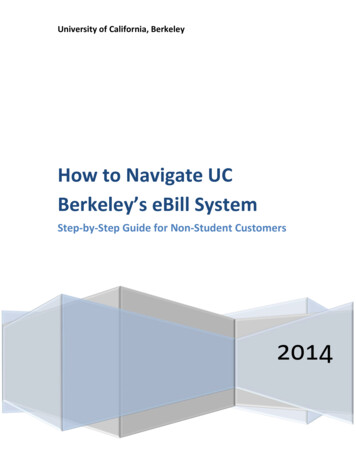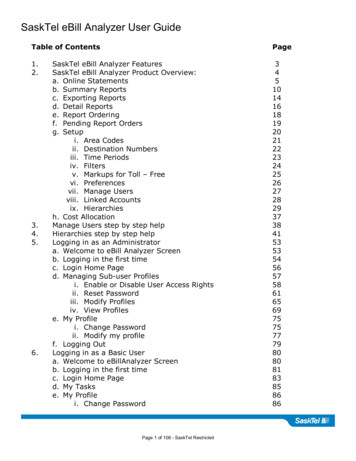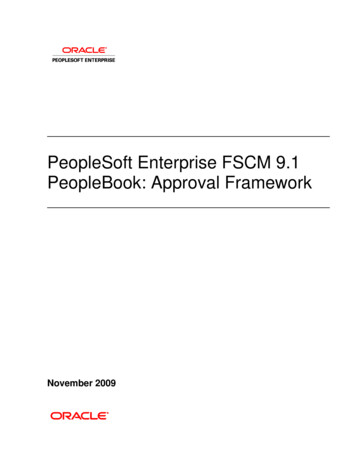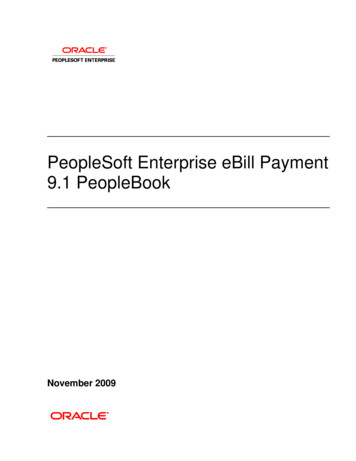
Transcription
PeopleSoft Enterprise eBill Payment9.1 PeopleBookNovember 2009
PeopleSoft Enterprise eBill Payment 9.1 PeopleBookSKU fscm91pbr0Copyright 1992, 2009, Oracle and/or its affiliates. All rights reserved.Trademark NoticeOracle is a registered trademark of Oracle Corporation and/or its affiliates. Other names may be trademarks of theirrespective owners.License Restrictions Warranty/Consequential Damages DisclaimerThis software and related documentation are provided under a license agreement containing restrictions on use anddisclosure and are protected by intellectual property laws. Except as expressly permitted in your license agreement orallowed by law, you may not use, copy, reproduce, translate, broadcast, modify, license, transmit, distribute, exhibit,perform, publish or display any part, in any form, or by any means. Reverse engineering, disassembly, or decompilationof this software, unless required by law for interoperability, is prohibited.Warranty DisclaimerThe information contained herein is subject to change without notice and is not warranted to be error-free. If you findany errors, please report them to us in writing.Restricted Rights NoticeIf this software or related documentation is delivered to the U.S. Government or anyone licensing it on behalf of the U.S.Government, the following notice is applicable:U.S. GOVERNMENT RIGHTSPrograms, software, databases, and related documentation and technical data delivered to U.S. Governmentcustomers are "commercial computer software" or "commercial technical data" pursuant to the applicableFederal Acquisition Regulation and agency-specific supplemental regulations. As such, the use, duplication,disclosure, modification, and adaptation shall be subject to the restrictions and license terms set forth in theapplicable Government contract, and, to the extent applicable by the terms of the Government contract, theadditional rights set forth in FAR 52.227-19, Commercial Computer Software License (December 2007).Oracle USA, Inc., 500 Oracle Parkway, Redwood City, CA 94065.Hazardous Applications NoticeThis software is developed for general use in a variety of information management applications. It is not developed orintended for use in any inherently dangerous applications, including applications which may create a risk of personalinjury. If you use this software in dangerous applications, then you shall be responsible to take all appropriate fail-safe,backup, redundancy and other measures to ensure the safe use of this software. Oracle Corporation and its affiliatesdisclaim any liability for any damages caused by use of this software in dangerous applications.Third Party Content, Products, and Services DisclaimerThis software and documentation may provide access to or information on content, products and services from thirdparties. Oracle Corporation and its affiliates are not responsible for and expressly disclaim all warranties of any kindwith respect to third party content, products and services. Oracle Corporation and its affiliates will not be responsible forany loss, costs, or damages incurred due to your access to or use of third party content, products or services.
ContentsPrefaceOracle's PeopleSoft Enterprise eBill Payment Preface . viiOracle's PeopleSoft Enterprise Products . viiPeopleSoft Application Fundamentals . viiPages With Deferred Processing . viiiPeopleBooks and the Online PeopleSoft Library . viiiCommon Elements Used in This PeopleBook . ixChapter 1Getting Started with PeopleSoft eBill Payment . 1PeopleSoft eBill Payment Business Processes . 1PeopleSoft eBill Payment Integrations . 1PeopleSoft eBill Payment Implementation . 2Chapter 2Preparing to Implement PeopleSoft eBill Payment . 3Setting Up PeopleSoft eBill Payment Security . 3Configuring PeopleSoft eBill Payment . 5Setting Up Paperless Invoicing . 5Chapter 3PeopleSoft eBill Payment Self-Service Transactions . 7Understanding PeopleSoft eBill Payment Self-Service Transactions . 7Accessing eBill Payment Transactions . 8Using the eBill Payment FAN page . 8Establishing eBill Payment User Experience . 9Pages Used to Establish PeopleSoft eBill Payment Preferences . 10Modifying Default Preferences . 10Selecting Customers . 13Modifying the User Profile . 13Copyright 1992, 2009, Oracle and/or its affiliates. All Rights Reserved.iii
ContentsViewing Bills .Pages Used to View Bills .Reviewing Nonconsolidated Invoiced Bills .Searching for Nonconsolidated Bills .Reviewing Invoice Details .Viewing Item Activity and Credit Card Payments in Progress .Reviewing Bill Line Details .Reviewing Discounts and Surcharges .Reviewing Tax Details .Emailing an Invoice Copy .Viewing an Invoice Image .Viewing Consolidated Bills .Pages Used to View Consolidated Bills .Reviewing Recent Consolidated Bills .Reviewing Attached Invoice Details .Viewing Supporting Documentation Attached to a Bill .Pages Used to View Supporting Documentation Attached to a Bill .Viewing a Supporting Document .Making Payments .Understanding the PeopleSoft eBill Payment Process .Pages Used to Make Payments .Displaying the Contents of the Payment Cart .Displaying the Contents of the Schedule Payment Cart .Initiating the Payment Process .Reviewing Amount Details .Entering Credit Card Payment Information .Verifying Credit Card Payments .Reviewing Credit Card Transaction Results .Reviewing Direct Debit Payment Information .Viewing Account Information .Pages Used to View Account Summary Information .Reviewing Account Summary, Recent Activity, and Aging Information .Viewing Open Item Balance Detail .Viewing Payment History .Pages Used to View Payment History .Reviewing Payments .Viewing Payment History Detail Information .Viewing Payment History Item Details .Viewing Balance Details .Pages Used to View Balance Details .Reviewing and Paying Items in PeopleSoft Receivables .Scheduling to pay on a future date .Searching for Items .Conversing with Customers .Pages Used to Converse with Customers ht 1992, 2009, Oracle and/or its affiliates. All Rights Reserved.
ContentsCreating and Submitting Conversations .Viewing Conversation Notes .Searching for Conversations .Reviewing and Responding to Customer Notes .42434343Chapter 4Using PeopleSoft eBill Payment Pagelets . 45Understanding PeopleSoft eBill Payment Pagelets .Pagelet Security .Viewing PeopleSoft eBill Payment Pagelets .Pagelets Used to View Billing and Account Information .45454646Index . 49Copyright 1992, 2009, Oracle and/or its affiliates. All Rights Reserved.v
Oracle's PeopleSoft Enterprise eBillPayment PrefaceThis preface discusses: Oracle's PeopleSoft Enterprise products. PeopleSoft application fundamentals. Common elements in this PeopleBook. Pages with deferred processing.Note. This PeopleBook documents only page elements that require additional explanation. If a page elementis not documented with the process or task in which it is used, then it either requires no additional explanationor is documented with the common elements for the section, chapter, or PeopleBook.Oracle's PeopleSoft Enterprise ProductsThis PeopleBook refers to these products: PeopleSoft Billing. PeopleSoft Accounts Receivable.PeopleSoft Application FundamentalsThe PeopleSoft Enterprise eBill Payment PeopleBook provides you with implementation and processinginformation for the PeopleSoft eBill Payment system. However, additional, essential information describingthe setup and design of the system resides in companion documentation. The companion documentationconsists of important topics that apply to many or all PeopleSoft applications across the Financials, EnterpriseService Automation, and Supply Chain Management product lines. You should be familiar with the contentsof these PeopleBooks.These companion PeopleBooks contain information that applies specifically to PeopleSoft eBill Payment. PeopleSoft Enterprise Application Fundamentals 9.1 PeopleBook. PeopleSoft Enterprise Global Options and Reports 9.1 PeopleBook. PeopleSoft Enterprise Order to Cash Common Information 9.1 PeopleBook. PeopleSoft Enterprise Bank Setup and Processing 9.1 PeopleBook. PeopleSoft Enterprise Commitment Control 9.1 PeopleBook. PeopleSoft Enterprise Managing Procurement PeopleBook.Copyright 1992, 2009, Oracle and/or its affiliates. All Rights Reserved.vii
Preface PeopleSoft Enterprise Managing Items 9.1 PeopleBook. PeopleSoft Enterprise Supply Chain Management Integration 9.1 PeopleBook. PeopleSoft Enterprise Setting Up and Using Engagement Planning PeopleBook. PeopleSoft Enterprise Billing 9.1 PeopleBookPages With Deferred ProcessingSeveral pages in PeopleSoft eBill Payment operate in deferred processing mode. Most fields on these pagesare not updated or validated until you save the page or refresh it by clicking a button, link, or tab. Thisdelayed processing has various implications for the field values on the page—for example, if a field containsa default value, any value you enter before the system updates the page overrides the default. Anotherimplication is that the system updates quantity balances or totals only when you save or otherwise refresh thepage.See AlsoPeopleTools 8.50 PeopleBook: PeopleSoft Application DesignerPeopleBooks and the Online PeopleSoft LibraryA companion PeopleBook called PeopleBooks and the Online PeopleSoft Library contains generalinformation, including:viii Understanding the PeopleSoft online library and related documentation. How to send PeopleSoft documentation comments and suggestions to Oracle. How to access hosted PeopleBooks, downloadable HTML PeopleBooks, and downloadable PDFPeopleBooks as well as documentation updates. Understanding PeopleBook structure. Typographical conventions and visual cues used in PeopleBooks. ISO country codes and currency codes. PeopleBooks that are common across multiple applications. Common elements used in PeopleBooks. Navigating the PeopleBooks interface and searching the PeopleSoft online library. Displaying and printing screen shots and graphics in PeopleBooks. How to manage the PeopleSoft online library including full-text searching and configuring a reverseproxy server.Copyright 1992, 2009, Oracle and/or its affiliates. All Rights Reserved.
Preface Understanding documentation integration and how to integrate customized documentation into the library. Glossary of useful PeopleSoft terms that are used in PeopleBooks.You can find this companion PeopleBook in your PeopleSoft online library.Common Elements Used in This PeopleBookAs of DateThe last date for which a report or process includes data.Add to Payment CartIf the bill or item is eligible for payment, a button or link appears to enable acustomer to add the corresponding item or bill to the payment cart, and navigateto the Payment Cart page, where they can view the content and update the itemsor bills in the payment cart.When a customer adds a consolidated bill to the payment cart, the systemdisplays each of the attached bills separately on the Payment Cart page.The contents of the payment cart will be saved when the user clicks the Add toPayment Cart button. Hence, the user can log out and log in again later tocontinue working with the payment cart.Add to SchedulePayment CartIf the bill or item is eligible for payment, a button or link appears to enable acustomer to add the corresponding item or bill to the schedule payment cart, andnavigate to the Schedule Payment Cart page, where they can view the contentand update the items or bills in the schedule payment cart.When a customer adds a consolidated bill to the schedule payment cart, thesystem displays each of the attached bills separately on the Schedule PaymentCart page.The contents of the schedule payment cart will be saved when the user clicks theAdd to Schedule Payment Cart button. Hence, the user can log out and log inagain later to continue working with the schedule payment cart.Bill SearchA customer can click to access the Bill Search page where they can enter searchcriteria to display a specific bill.Business UnitAn identification code that represents a high-level organization of businessinformation. You can use a business unit to define regional or departmental unitswithin a larger organization.Current BalanceThe total amount of the invoice reduced by any payments paid toward theinvoice. The system calculates the balance by summing the BAL AMT value ofall items for the invoice in the PS ITEM table, reduced by any credit cardpayments that are in process. If the item has not yet been created in PeopleSoftReceivables, the system retrieves the balance from the BI HDR Invoice Amountfield.DescriptionDescriptive text up to 30 characters.Copyright 1992, 2009, Oracle and/or its affiliates. All Rights Reserved.ix
PrefaceDue DateThe date on which payment is due. The system calculates due date by taking theminimum due date of all open items for the invoice from the PS ITEM table. Ifthe item has not yet been created in PeopleSoft Receivables, the system retrievesthe date from the BI HDR due date.Effective DateDate on which a table row becomes effective; the date that an action begins. Forexample, if you want to close out a ledger on June 30, the effective date for theledger closing would be July 1. This date also determines when you can view andchange the information. Pages or panels and batch processes that use theinformation use the current row.EmplID (employee ID)Unique identification code for an individual associated with an organization.SubtotalTotal line amount before discounts and surcharges.Invoice AmountTotal amount owed for the bill.Invoice DateDate on which the bill was invoiced.Item IDID of the item. For example, if the item is an invoice, this value represents theinvoice number.When searching for a specific Item ID, customers can search for a specific itemID, or enter a partial Item ID to display a list of all possible values.Item StatusIf the item has a balance of zero, the status is Closed. Otherwise, the status isOpen.Language and Language The language in which you want the field labels and report headings of reports toprint. The field values appear as you enter them.CodeLanguage also refers to the language spoken by an employee, applicant, or nonemployee.xNet Extended Amt (netextended amount)The total gross amount, plus all surcharges, reduced by all applicable reductionsfor the bill.QuantityThe quantity of the description item billed on the corresponding bill line.Return to Bill ListFrom the Bills - Bill Summary page, a customer can click to return to the Bills Bill List page. From the Consolidated Bills - Consolidated Bill Summary page, acustomer can click to return to the Consolidated Bills - Bill List page.User IDThe system identifier for the individual who generates a transaction.SetIDAn identification code that represents a set of control table information orTableSets. A TableSet is a group of tables (records) necessary to define anorganization's structure and processing options.Total DiscountsThe total discounts associated with the bill.Total SurchargesThe total surcharges associated with the bill.Copyright 1992, 2009, Oracle and/or its affiliates. All Rights Reserved.
PrefaceTypeThe item type–for example, an invoice, debit memo, or credit memo.UOM (unit of measure)The unit of measure code that represents the unit used to quantify the item on thecorresponding bill line.Unit PriceThe price billed for each item on the corresponding bill line.Copyright 1992, 2009, Oracle and/or its affiliates. All Rights Reserved.xi
Chapter 1Getting Started with PeopleSoft eBillPaymentThis chapter discusses PeopleSoft Enterprise eBill Payment: Business processes. Integrations. Implementation tasks.See Also"Oracle's PeopleSoft Enterprise eBill Payment Preface," page viiPeopleSoft eBill Payment Business ProcessesPeopleSoft eBill Payment enables a customer to initiate these business processes: View bills. Edit account information. Pay bills. View payment information. Create customer conversations. Choose invoice delivery options.PeopleSoft eBill Payment IntegrationsPeopleSoft eBill Payment sits on top of PeopleSoft Enterprise Billing and PeopleSoft Enterprise Receivables,so there is no effort required to integrate an electronic bill. PeopleSoft eBill Payment enables faster collectionof receivables with less opportunity for errors, and it is easy to implement. Customers need not wait for aninvoice, and invoices can be paid anytime, from anywhere. With PeopleSoft eBill Payment integration, youcan:Copyright 1992, 2009, Oracle and/or its affiliates. All Rights Reserved.1
Getting Started with PeopleSoft eBill PaymentChapter 1 Facilitate paperless invoicing. Receive invoice information from PeopleSoft Billing. Apply payments to PeopleSoft Receivables. Enable your customers to view additional information that is not on paper invoices. Allow customers to update their contact information, like billing address, phone number and credit cardinformation.PeopleSoft eBill Payment ImplementationPeopleSoft eBill Payment does not require implementation steps. In the planning phase of implementation,take advantage of all PeopleSoft sources of information, including the installation guides, table-loadingsequences, data models, and business process maps. A complete list of these resources appears in the prefacein the PeopleSoft Enterprise Application Fundamentals PeopleBook, with information about where to find themost current version of each.2Copyright 1992, 2009, Oracle and/or its affiliates. All Rights Reserved.
Chapter 2Preparing to Implement PeopleSoft eBillPaymentPeopleSoft eBill Payment self-service applications enable customers to receive invoices, access supportinginformation and make payments using the internet. Self-service applications are an improved alternative toautomated telephone prompting systems, and reduce the workload for internal support staff and customerservice representatives.This chapter discusses how to: Set up PeopleSoft eBill Payment security. Configure PeopleSoft eBill Payment. Set up paperless invoicing.Note. To implement PeopleSoft eBill Payment, you must first set up PeopleSoft Billing and PeopleSoftReceivables applications.Setting Up PeopleSoft eBill Payment SecurityThe PeopleSoft eBill Payment transactions are set up to secure the information that is accessible to customers.In order for customers to use the PeopleSoft eBill Payment transactions, you must first grant those customersaccess to the transactions and set up appropriate row-level security for their user IDs.To enable customers to access PeopleSoft eBill Payment pages:Copyright 1992, 2009, Oracle and/or its affiliates. All Rights Reserved.3
Preparing to Implement PeopleSoft eBill PaymentChapter 21. Set up the user profile for the customer contact that requires access to eBill Payment.a. Select Customers, Contact Information and edit the customer contact needing access to eBill Payment(or create a new contact, as appropriate).b. Click the User Profile link at the bottom of the Contact Information page.c. Enter a User ID and Password. The customer contact will use these values to log into the eBillPayment application.d. Verify that the Locked Out? box is not selected.e. Assign the appropriate permission lists and Contact Roles to allow the user to run PeopleSoft eBillPayment processes.For example, you could assign the EPEB1000 permission list, which enables the user to run the Emailme and Invoice Copy process. The roles that you assign to the contact determine which self-servicetransactions the contact has access to. You could, for example, assign the Customer role to customercontacts. If you are using the Customer role and PeopleSoft Billing is not installed, remove thepermission list EPEB4000 from the Customer role. This prevents the PeopleSoft Billing links fromappearing in PeopleSoft eBill Payment.f. Save.2. Click the Contact Customer Information link to access the Contact Customer page.Enter the customers that are associated with the contact. The Contact Customer page contains a grid thatis used to enter the customers that are associated with the contact.3. Click the Self Service Security tab.Select the Bill To option to designate which customer data is accessible from PeopleSoft eBill Payment.When a customer contact accesses PeopleSoft eBill Payment, the system displays data for only thecustomers that have the bill to option selected on the Self Service Security page. Row-level security ismaintained in this manner for PeopleSoft eBill Payment users.4. To set up invoice delivery and notification options, click the Documentation link on the Customer tab foreach customer.a. Create a row in the Documentation grid with a document code of INVC (invoice).b. Select the preferred communication method for invoices. The value chosen will be used to derive thedefault value of the Invoice Media setting when a new bill is created online or through the BillingInterface. If you want paperless invoicing, you can select Email Notification to have the officialinvoice delivered as an email which contains a link to view the invoice in eBill Payment.Note. You can create the user profile on the Contact User Profile page, or you can use the PeopleTools UserProfiles component. If you use the User Profiles component, select Customer Contact for the ID type, andthen assign the appropriate contact ID to the attribute value.See AlsoPeopleTools 8.50 PeopleBook: Security AdministrationPeopleSoft Enterprise Order to Cash Common Information 9.1 PeopleBook, "Maintaining Contacts"4Copyright 1992, 2009, Oracle and/or its affiliates. All Rights Reserved.
Chapter 2Preparing to Implement PeopleSoft eBill PaymentConfiguring PeopleSoft eBill PaymentPeopleSoft eBill Payment uses the CUSTOMERDEF SWAN style sheet. This style sheet is intended forexternally facing applications. You can change styles and colors through PeopleSoft Application Designerand the Style Sheet object. The use of a different style sheet from PSSTYLEDFF SWAN (used for internallyfacing applications) enables you to create a unique-looking
These companion PeopleBooks contain information that applies specifically to PeopleSoft eBill Payment. PeopleSoft Enterprise Application Fundamentals 9.1 PeopleBook. PeopleSoft Enterprise Global Options and Reports 9.1 PeopleBook. PeopleSoft Enterprise Order to Cash Common Information 9.1 PeopleBook.
